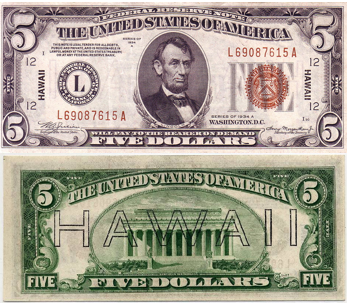Hawaii Dollars
The U.S. Constitution specifically gives Congress the power to coin money, and an 1884 Supreme Court decision makes it clear that this power also applies to paper currency (in that case, backed by gold.) And with rare exceptions, money printed for use in one state is valid for use in the other states and American territories. One exception: the bills pictured, below.

On December 7, 1941, Japan bombed Pearl Harbor, Hawaii, bringing the U.S. into World War II in the process. Hawaii (not yet a state) was isolated both geographically and politically and — given the losses at Pearl Harbor especially — was the most likely widely-inhabited American candidate for a successful Japanese occupation. Any successful occupation would also allow the invading Japanese to seize, potentially, hundreds of millions of dollars in currency from Hawaiian financial institutions. With federal spending still in the tens of billions, such an outcome would have been significantly harmful to the American economy. The HAWAII-emblazoned bills were the solution.
In January of 1942, the military governor of Hawaii (the territory was under the military’s control after the Pearl Harbor bombing) recalled most of the currency in the future state, with some allowances so as to not pull all of the cash out of the islands’ economy. Five months later, bills like the one pictured — called “Hawaii overprint notes” — were issued. The theory was simple: if Hawaii fell into Japanese hands, these bills would no longer be legal tender in the United States. This contingency plan never came into play.
In total, over 65 million Hawaii overprint notes were created (totaling over $300 million), in four denominations — $1, $5, $10, and $20, with the $5 note pictured above being the rarest of the quartet. On October 21, 1944, ten months before Victory over Japan Day, the required use of these bills ceased.
Bonus fact: Some Hawaii overprint bills — as well as some regular currency — have asterisks after their serial numbers. These bills, called “star notes” (see one here), replaced bills that had errors rendering them unsuitable for circulation. In order to keep the bill count correct, the serial numbers are re-used, with the asterisk included as an indicator that another bill with that number also may exist somewhere.
From the Archives: The One Hundred Trillion Dollar Bill: Zimbabwean inflation was incredibly out of control, leading to the creation of a bill in an absurdly high denomination.
Related: After the war, the Hawaii overprint bills were recalled, but not all of them were turned in. With over 35 million $1 Hawaii overprint Silver Certificates printed, some are still floating around as collectibles — at thirty times their face value. Want a star note? That will run you about seven dollars.

Leave a comment